The Museum Collections
Introduction
I. History and Art Collection
1. Icons of the 14th – 19th centuries
icons of the 14th – 17th century
2. Jewelry art of the 14th – 20th century
jewelry art of the 14th – 17th century
jewelry art of the 18th – 19th century
the european silver 14th - 19th centuries
3. Small-size sculptures (works of metal, wood, bone)
XI – the beginning of the XX century
Small-size sculptures 11th – 17th century
Small-size sculptures 18th – early 20th century
enamel of Troitza masters 15-8th – early 20th century
5.Embroidery, lace, textiles of the 14th - early 20th century
icon and ornamental embroidery
gold and silver lace
6.Painting of the 18th – 21st centuries
painting of the 18th – 19th centuris
painting of the 20th – 21st centuris
II.Manuscripts and old printed books of the 14th – 17th century
IV.Lithography of the 18th – 19th century
V.Numismatics
VI.Medals of the 18th - early 20th century
VIII.Archeology collection
IX. Russian folk and applied and decorative art of the 17th – 21st c.
1. Artistic wood
folk carved and painted wood
wooden toys
house carving of Sergiev Posad
Khokhloma and Gorodets painting
2. Artistic textiles
embroidery and weaving
printed textiles and lace
Russian shawls
folk costumes
folk garments
printed cotton kerchiefs
|
Folk carved and painted wood 18th-19th centuries (P.2) |
From all wooden subjects of a life and work tools the distaff has remained better. Distaffs were among the most cherished possessions of Russian women. They were handed down from generation to generation. Even nowaday in the villages of the Russian North distaffs are kept in the family in memory of a mother or grandmother. This subject, as memory of mother remained even presently in country houses of the North ¬ of Russia. That has made possible today to gather the richest collection,¬ which includes almost all versions of distaffs of Russian North and areas of the Top Volga Area.
Expeditions sponsored by Zagorsk Museum, for instance, have helped to distinguish previously unidentified centres of traditional arts and crafts characterised by their distinctive styles and techniques.
At present, more than thirty types of Russian distaffs are known. They differ both in their design and shape and in the style of their carved and painted decorations. According to their design, distaffs are of two kinds: one-piece distaffs made of the root and trunk of a tree, and two-piece distaffs consisting of the base on which the spinner sits, and the detachable comb. Research carried out in the last few decades has made it possible to define the parts of the country where these two types occur. One-piece distaffs were made in the North of the European part of Russia while detachable distaffs in their classical form were produced in the Gorky Region of the Povolzhye Area. Of the one-piece distaffs the so-called terem-type distaffs (resembl¬ing a house with a tent-shaped roof) from the Yaroslavl Region and those common in the Bui and Griazovets Districts have consistently preserved the original ancient design.
|
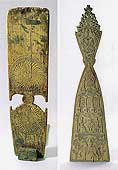
Distaff. 19th century. Tver Region. “Terem-type distaff . 19th century. Yaroslavl Region |
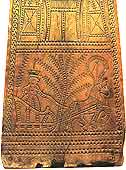
“Terem-type distaff ( fragment « Horseman »). 19th century. Yaroslavl Region |
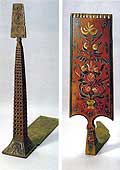
“Columnar” distaff. 19th century. Yaroslavl Region. Distaff. 19th century. The North |
|
|
The district of Tarnoga in the Volga Region was the classical centre of large-size decorative three-faceted carving. The Tarnoga distaff is archaic in its shape. In the remote past the huge rectangular blade was evidently fixed straight onto the base. Later the blade was given a stem, and the distaff acquired the shape of a spade. The form distaffs of Tarnoga is archaic. Craftsmen either carved the blade with a design consisting of just a few large components which were arranged in such a way as to accentuate the texture of the wood, or, less frequently, they covered the entire surface of the blade with an extremely fine detailed ornament.
Quite a different type of three-faceted carving was developed to the South of Tarnoga, in the villages scattered on the densely forested banks of the Pechenga. The large blade was literally strewn with the minute details of an extremely fine ornament executed with virtuoso skill. The sparkling facets of the carving form an intricate design. The distaffs from the adjacent Totma District are of a different shape. They are distinguished by their rather large, almost square blade on a tall stem. The blade has a lace-like openworked lattice at the top and two pendants, which look rather- like ear-rings, at the corners of the lower part. Three-faceted carving with a rosette as the main element of the pattern cover the blade as well as the front and the sides of the stem. The carving is brightly painted.
|
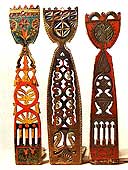
Distaffs. Late 19th century. Vologda Region |

Distaff’s blade. Late 19th century. Vologda Region |
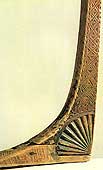
Distaff’s leg. 1890. Vologda Region |
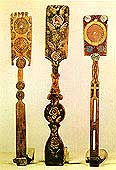
Distaffs. Late19th century. Vologda Region (Totma 3) |
|
|
The findings of the 1959 expedition from Zagorsk Museum helped to distinguish five centres of local art tradition in the Northern Dvina Area which has always been famous for painted woodwork. Each of the five centres—Permogorye, Rakulka, Borok, Puchuga, and Toima—has its own identifiable style. However, here too, distaffs were decorated with the greatest care. Permogorye distaffs are distinguished by the so-called graphic style of decoration. First, a distaff was painted white. Then, a preliminary drawing was made.
The types of painted ornament found on the distaffs produced in Borok are to a certain extent stylistically derived from the Northern Icons. Borok had long-standing identifiable traditions of composi¬tion and painting. The Rakulka distaffs, unlike those made in the Permogorye and Borok Regions, are distinguished by an ochre-yellow background and a large-size design. Scenes from everyday life were never depicted. The upper part of the blade was usually decorated with the design of a curving branch with spear-shaped leaves outlined with black tendrils. Below, in a square frame, there was an outline, in black, of a bird.
|

Distaff’s blade. First half of the 19th century. Arkhangel Region (Permogorie) |

Distaff. First half of the 19th century. Arkhangel Region (Borok) |

Distaffs. 19th centuries. Arkhangel Region (Rakulka) |
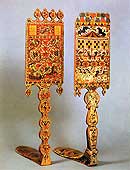
Distaffs. Late 19th century. Arkhangel Region |
Distaffs and hampers produced in the Mezen Region were very popular in the nineteenth and twentieth centuries. They were painted in the village of Palashchelye. The variety of ornamental motifs appears to be of very ancient origin. An extremely rhythmical design combined geometric ornaments with friezes showing horses and deers. The warm golden colour of the background perfectly matches the reddish-brown of the design outlined in black. Compared with the big spade-like distaff of the Russian North, the graceful oarlike distaffs found in Karelia and on the coast of the White Sea look fascinating and beautiful Their unusual form can be accounted for by local Ugro-Finnish traditions. The distaffs found on the Onega Peninsula, which were considered to be Pomorye distaffs in the earlier classification of Russian distaffs, are distinguished by their especially fine carving and elaborate design.
In the Archangel Region, besides the usual carved and painted spade-like distaffs one comes across distaffs with a very short stem and a tall wide blade. They were found in the villages situated on the upper reaches of the Onega, near the old town of Kargopol, and still further west, near Kenozero and at Liadiny (a group of hamlets). South of the Archangel Region, in the Novgorod, Tver and even the Pskov Regions, one also finds distaffs with a tall wide blade and a very short stem. The decorative components, though, vary from region to region .
|

Distaffs. 19th centuries. Arkhangel Region (Mezen river) |
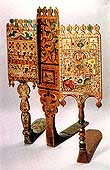
Distaffs. 19th centuries. Arkhangel Region (Northern Dvina river) |

Distaffs. Late 19th century. Arkhangel Region |

Distaff. Late 19th century. Pskov Region
|
|


